By George W. Chapman

Depending on where you stand, the corporatization of healthcare is either an unnecessary and unwanted intrusion into your healthcare or a welcome improvement. Amazon, the corporate giant with seemingly unlimited resources, has partnered with Teladoc, an online 24/7medical service, to provide virtual on demand, non-emergent care. On the surface, 24/7 telemedicine urgent care provided by out-of-network providers is not new. The twist here is you contact the provider through an echo device like Alexa. As crazy as it sounds, several hospital and physician systems have already signed up, including Boston Children’s, Cedars Sinai and Houston Methodist. It remains to be seen how well out of network Teladocs can be successfully integrated into comprehensive hospital and physician systems that are in the midst of organizing to accept reimbursement from insurance companies based upon value added or overall outcomes. Alexa type Teladoc services can relieve the pressure on overworked hospital and their network providers and certainly offer consumers convenience. Unless these services are effectively integrated into hospital and physician systems, they will be perceived as intrusions upon and leakage from value-based care.
Telemedicine in Jeopardy
They say necessity is the mother of invention. When it came to telemedicine, the necessity created by the pandemic didn’t exactly invent telemedicine, but it certainly expanded its use to the point where it is now firmly entrenched in healthcare delivery. When a public health emergency was declared two years ago to combat the virus, Congress and Medicare authorized both the expanded use of telemedicine and enhanced reimbursement to providers. Providers are paid the same for in-person and virtual visits.
Telemedicine proved to be a critical and effective tool to combat the virus, protect staff from infected patients and not harm providers financially. The senate just voted 48-47, along party lines, to terminate the PHE. It now goes to Congress.
If passed, it could virtually kill telemedicine. Providers cannot afford to offer telemedicine if there is a return to pre-pandemic inadequate reimbursement. And consumers, who have come to embrace telemedicine, will be denied a convenient way to access and maintain their care. President Biden has threatened to veto the bill.
More COVID-19 Money
The Office of Management and Budget is requesting another $22.5 billion from Congress to continue the fight against the virus.
Just over half of the new funding would go toward buying more medicines, vaccines, boosters, oral anti-virals and monoclonal antibodies to treat those infected. Roughly $2 billion is for testing and much needed financial support for inundated commercial and public health labs. $1.5 billion will provide coverage for the uninsured and a similar amount is slated for research on next generation vaccines. The bill contains no additional relief for hospitals and physicians who have absorbed both financial and staffing losses fighting the virus over the last two years. To add insult to injury, a moratorium on a bill that would reduce their reimbursement by 2% expires in April.
CVS Philanthropy?
The retail drug giant announced it invested $185 million in 6,600 affordable housing units in several cities throughout the US.
Poor or lack of safe housing is a social determinant that negatively impacts both access to and outcome of care. Residents of the CVS subsidized housing now have access to a variety of services conveniently provided by CVS-like pharmacies, durable medical equipment and clinics. Kudos to CVS. Right? Last year, CVS revenues were $77 billion, resulting in net cash flow of an astounding $13 billion. The $187 million “investment” in affordable housing is a paltry 1.4% of their $13 billion net cash flow. It is virtually nothing compared to $77 billion in revenues. So, is there an ulterior motive? You be the judge. Hospitals and physician healthcare systems can’t afford to provide subsidized housing to improve the care provided to their patients. Their reimbursement is fixed by Congress and Medicare and commercial insurers typically follow suit. Drug prices continue to escalate unregulated or encumbered by Congress andMedicare, so CVS and other drug giants can easily afford to reinvest their profits and capture market share.
Physician Shortage Addressed
Aging baby boomers and early retirement due the pandemic have increased fears of an impending physician shortage. Certainly, the unencumbered increase in nurse practitioners and physician assistants has helped mitigate the shortage. But there has not been an increase in the number of encumbered physician residency slots in decades. Congress and Medicare finally authorized the funding of an additional 1,000 residency slots in teaching hospitals with emphasis on hospitals serving health professional shortage areas which are typically inner city and rural. Medicare pays hospitals for resident salaries and related teaching expenses. The biggest change in residency slots will be a preference among hospitals for primary care versus specialty slots.
Cost of Insulin
Diabetes is one of our most pervasive, but treatable, chronic conditions impacting the lives of millions. President Biden vowed to cut the cost of insulin when he addressed the union in early March. One in four insulin users cannot afford to use the drug as prescribed, which inevitably will result in other serious conditions. Since not one for-profit insulin manufacturer has offered to help, not-for-profit drug manufacturer Civica Rx is partnering with BlueCross BlueShield and health system giants Intermountain Health, Trinity Health, and Kaiser Permanente to develop and distribute affordable insulin at about $30 a vial by 2024. The price will be based solely on the cost of development, production and distribution. It will be interesting to see if this competition causes current manufacturers to lower their prices.

